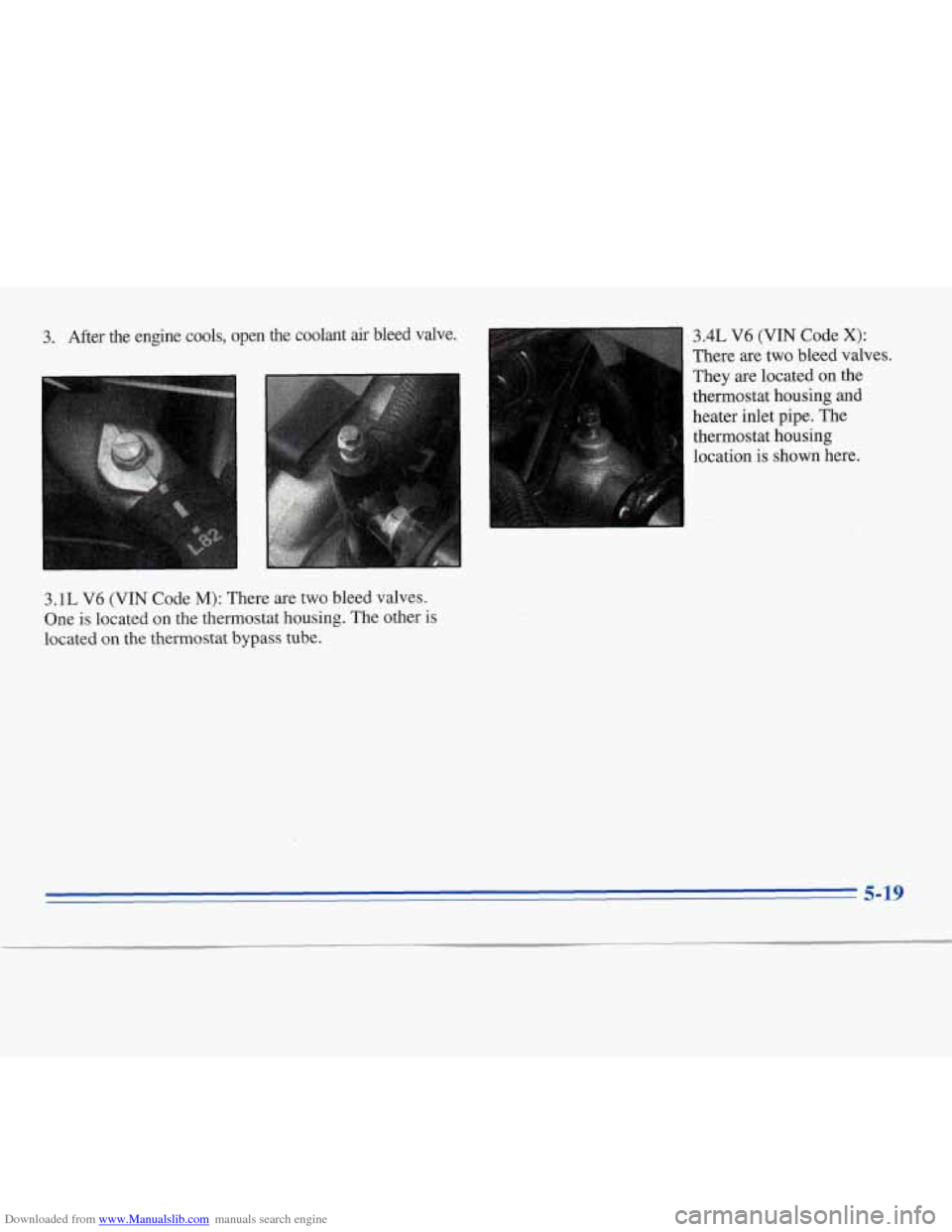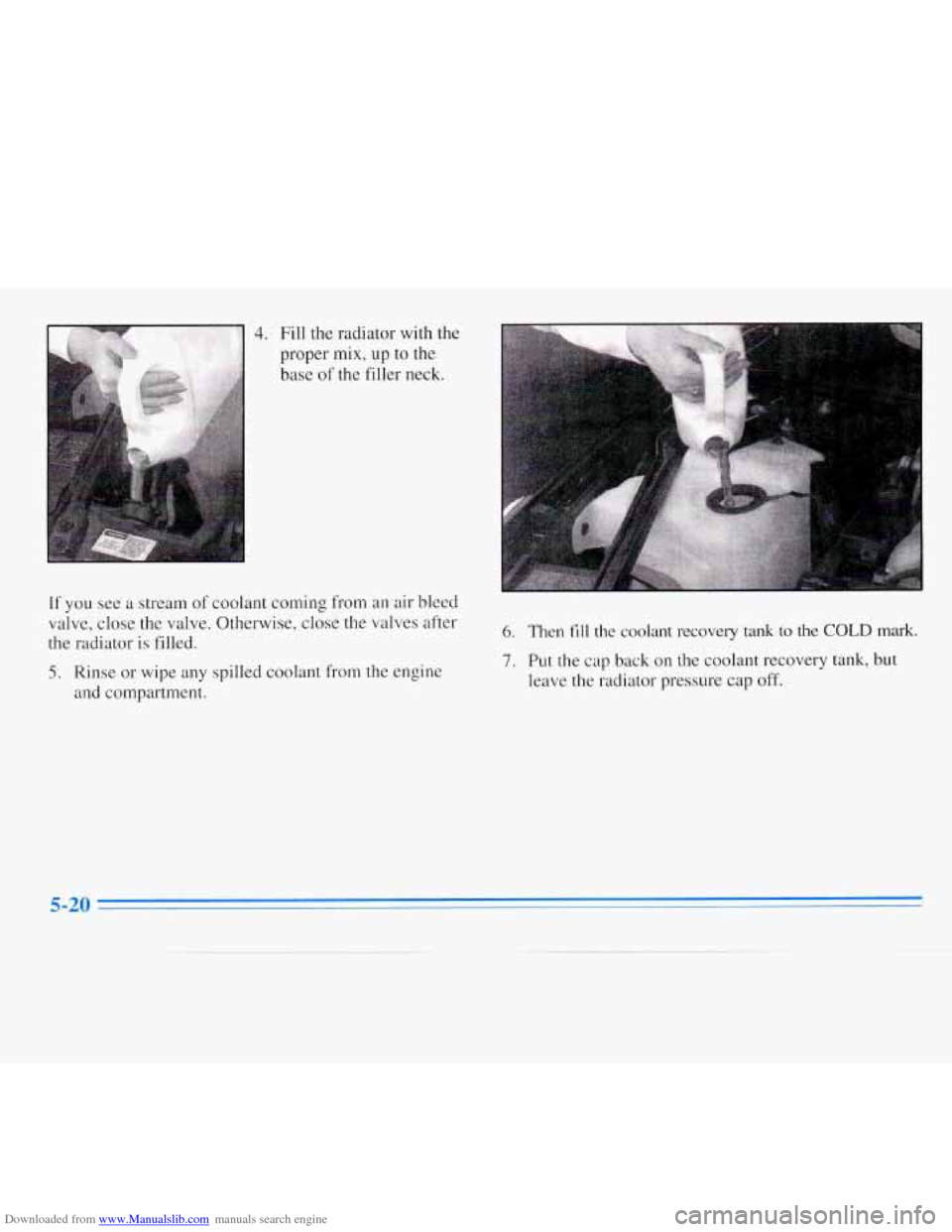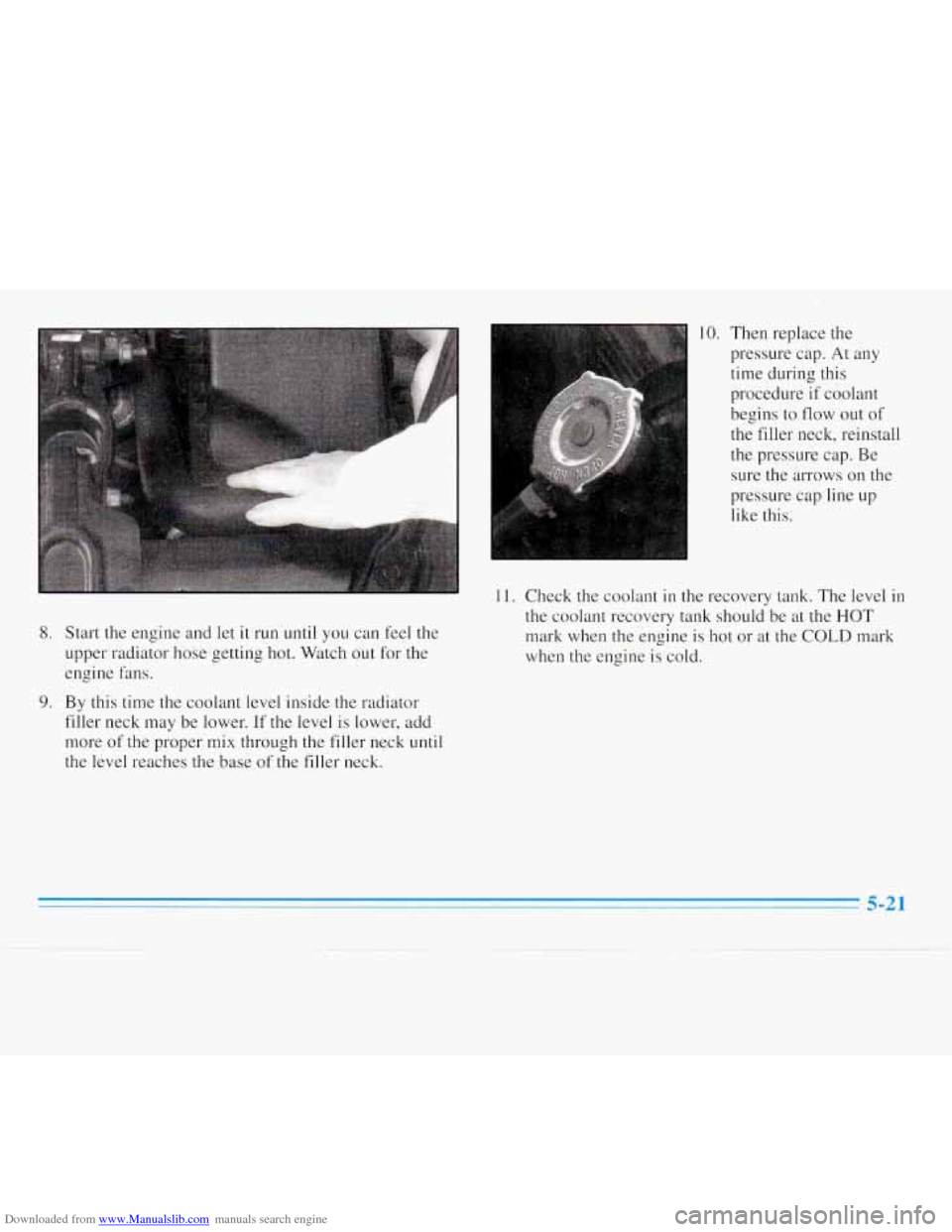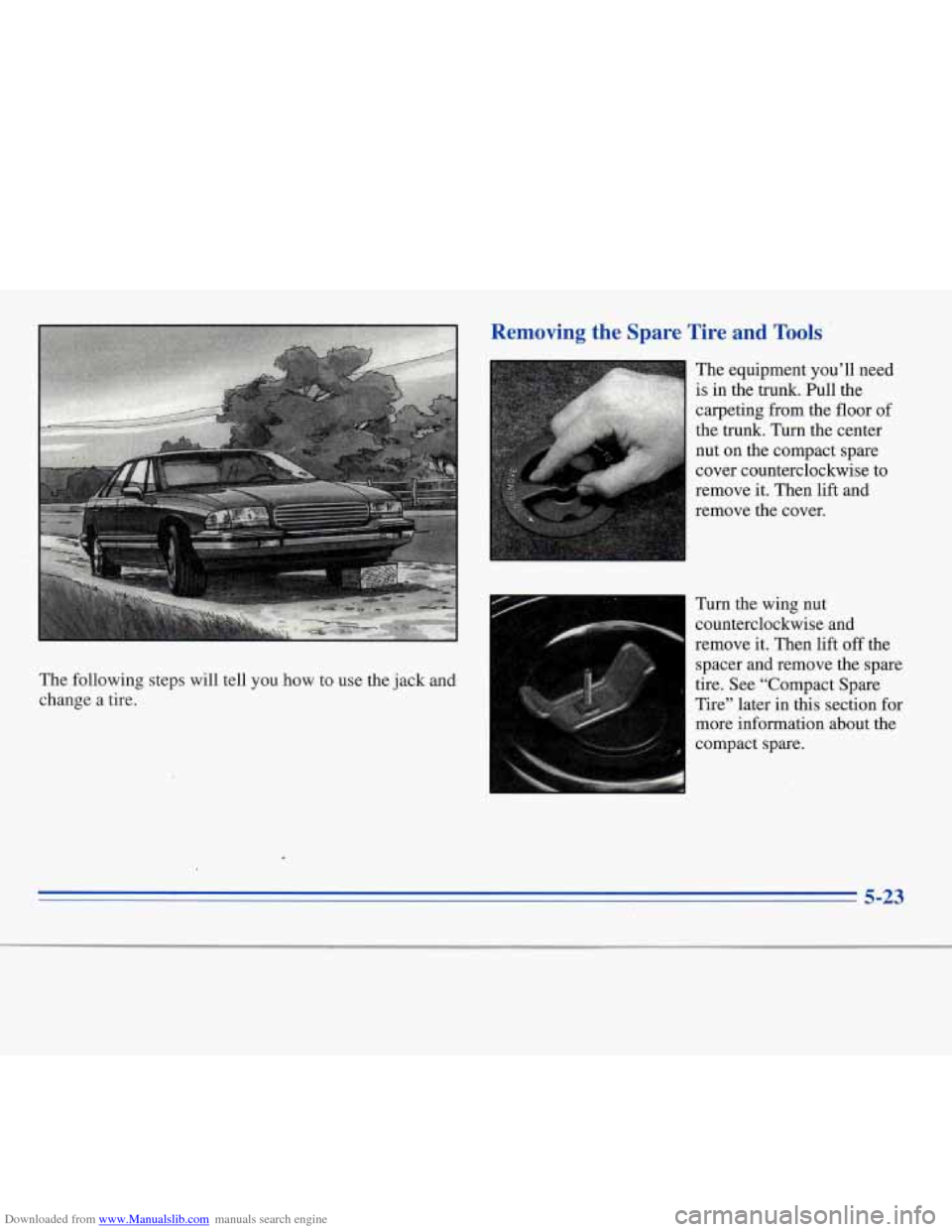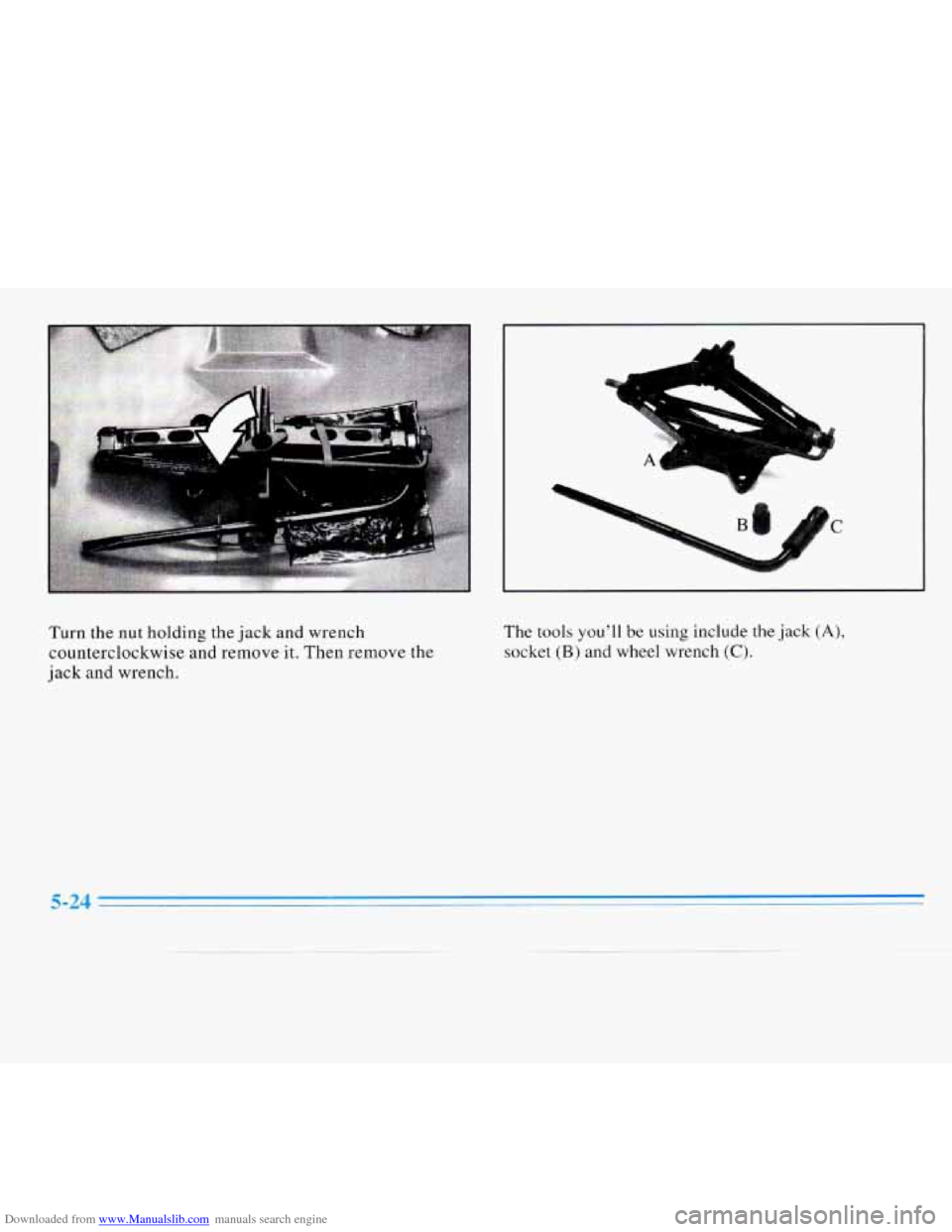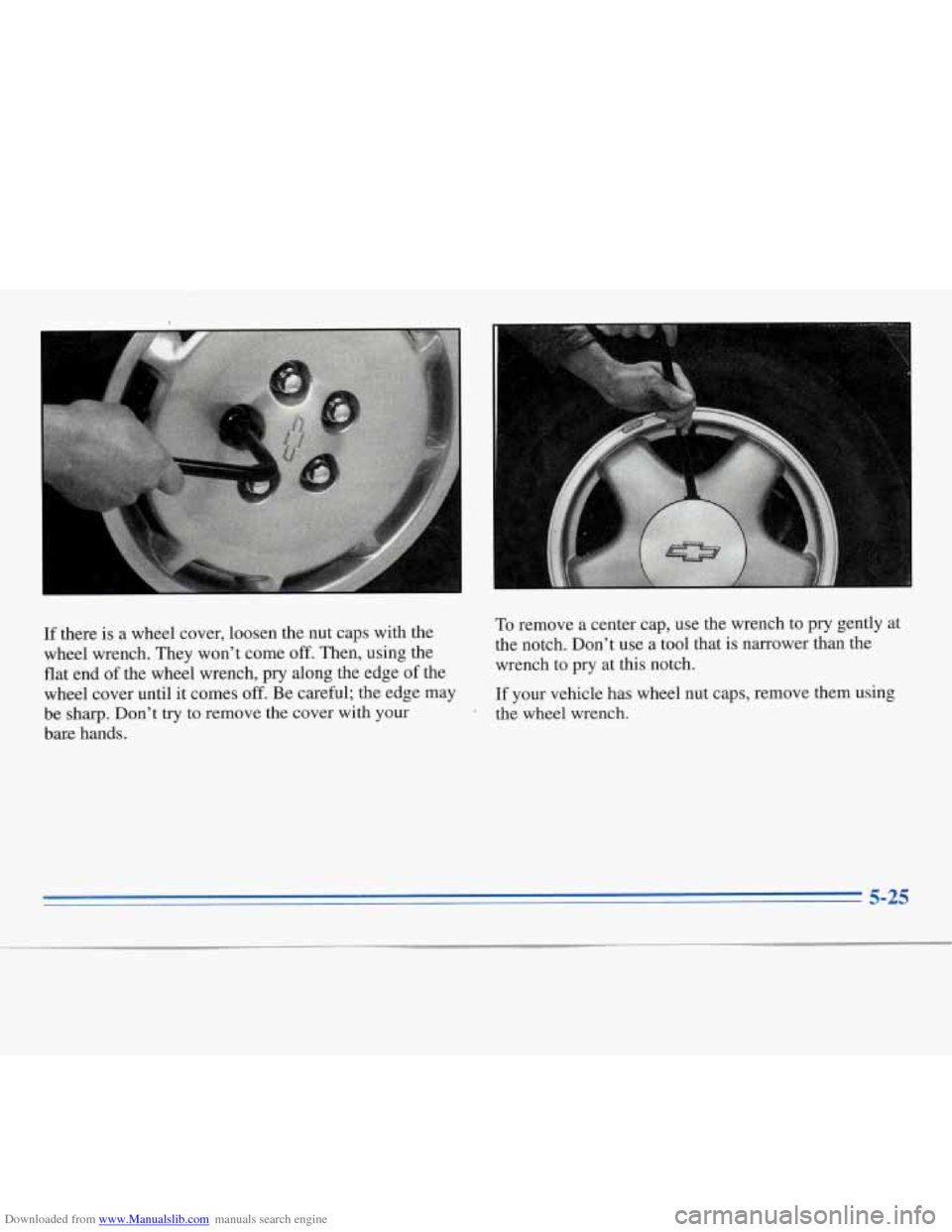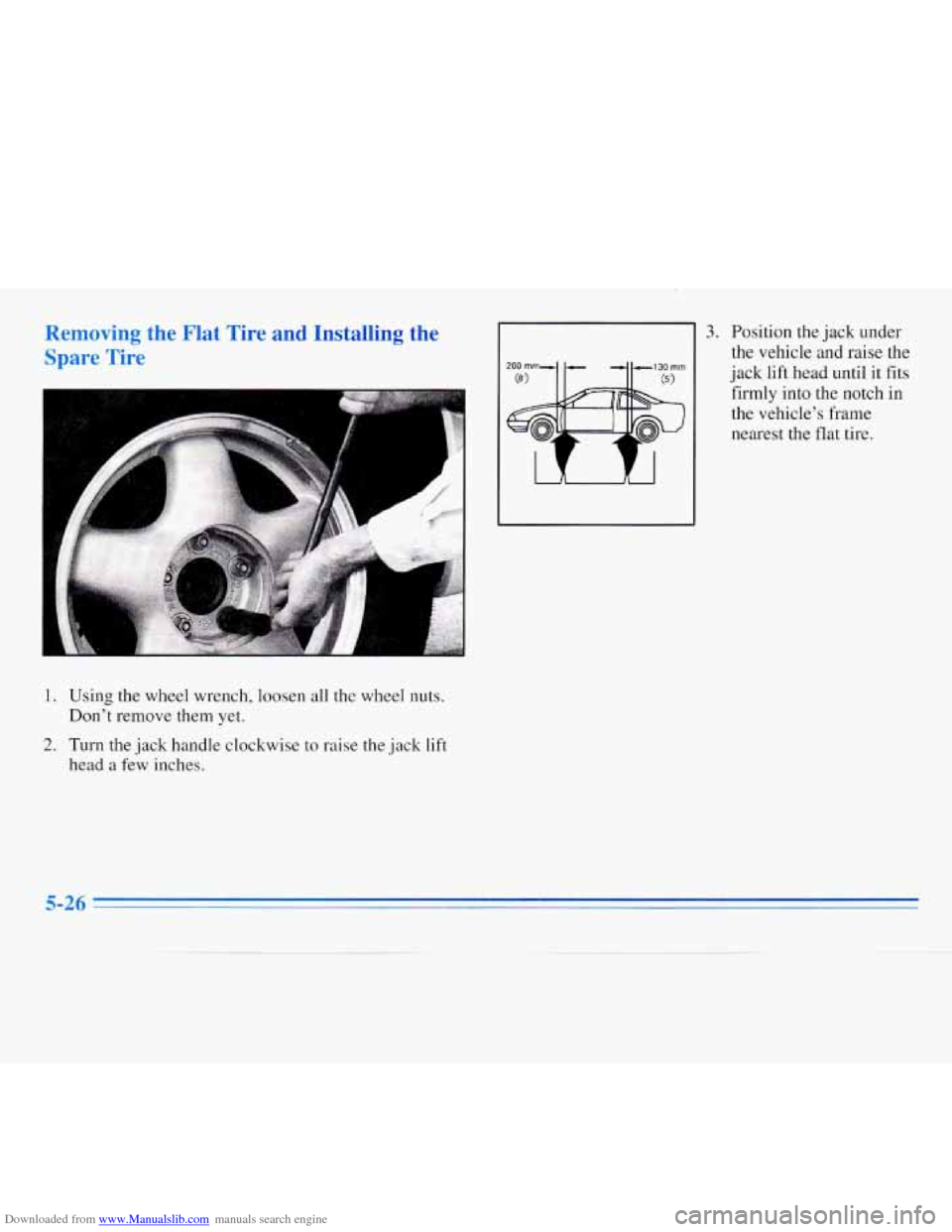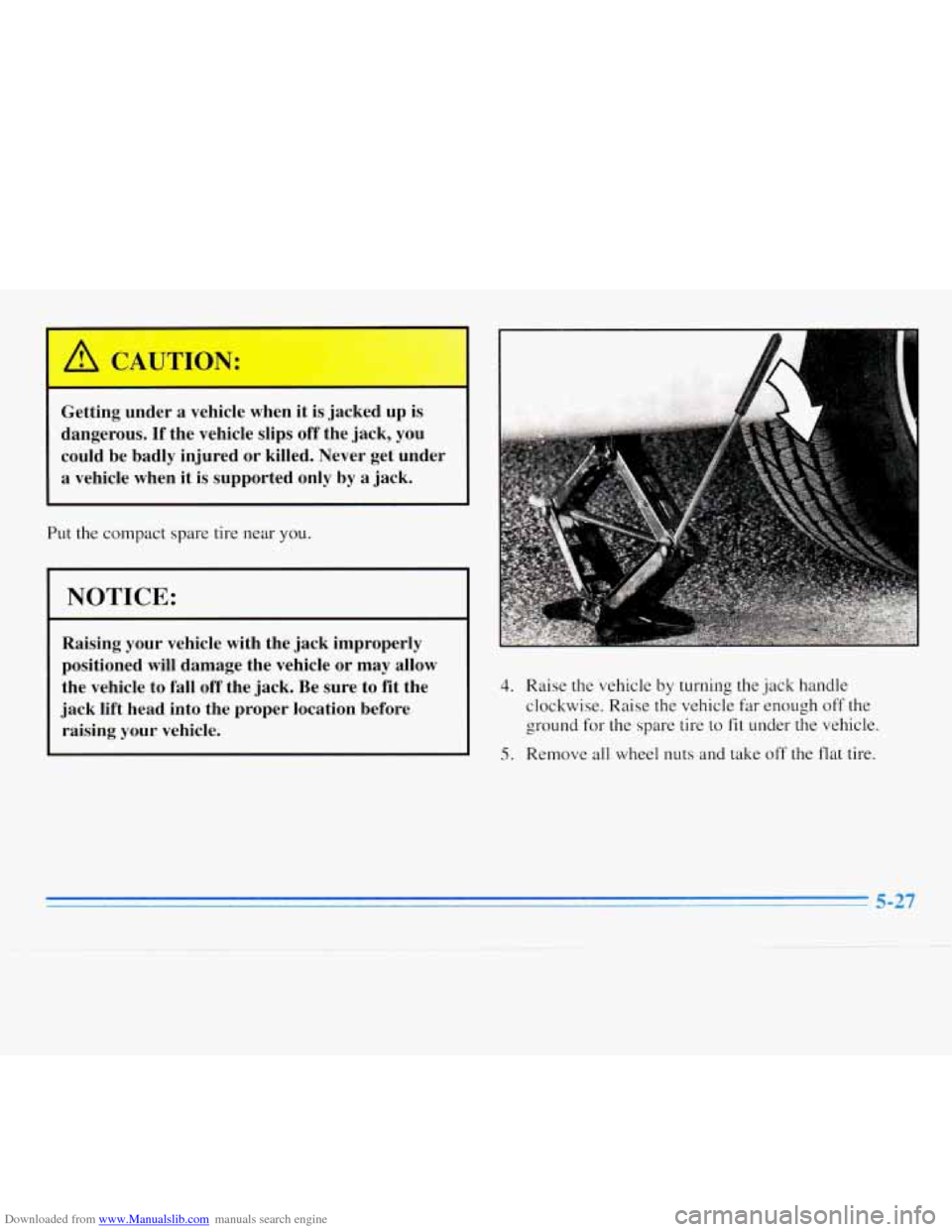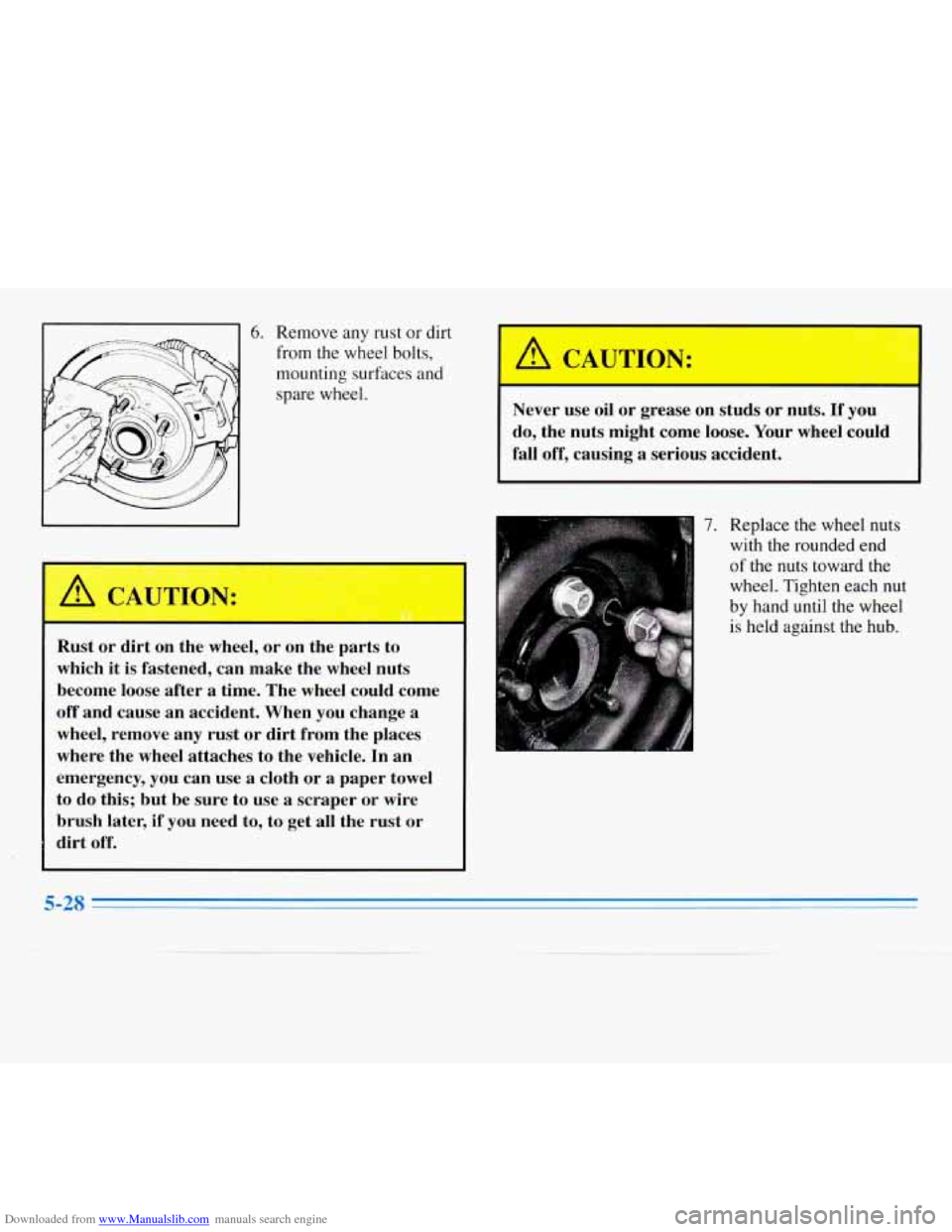CHEVROLET MONTE CARLO 1996 5.G Owners Manual
MONTE CARLO 1996 5.G
CHEVROLET
CHEVROLET
https://www.carmanualsonline.info/img/24/8241/w960_8241-0.png
CHEVROLET MONTE CARLO 1996 5.G Owners Manual
Trending: jump start, service indicator, lock, clock reset, wheel torque, roof, glove box
Page 191 of 340
Downloaded from www.Manualslib.com manuals search engine 3. After the engine cools, open the coolant air bleed valve. 3.4L V6 (VIN Code X):
There are two bleed valves.
'hey
are located on the
thermostat housing and
heater inlet pipe. The lermostat housing
i location is shown here.
I
3.1L V6 (VIN Code M): There are two bleed valves.
One is located on the thermostat housing. The other is
located on the thermostat bypass tube.
5-19
Page 192 of 340
Downloaded from www.Manualslib.com manuals search engine If you see a stream of coolant coming from an air bleed
valve, close the valve. Otherwise, close the valves after
the radiator
is filled.
5. Rinse or wipe any spilled coolant from the engine
and compartment.
6. Then fill the coolant recovery tank to the COLD mark.
7. Put the cap back on the coolant recovery tank, but
leave the radiator pressure cap off.
Page 193 of 340
Downloaded from www.Manualslib.com manuals search engine 8. Start the engine and let it run until you can feel the
upper radiator hose getting hot. Watch out for the
engine fans.
9. By this time the coolant level inside the r' d d' lator
filler neck may be lower. If
the level is lower, add
more
of the proper mix through the filler neck until
the level reaches the base of the filler neck.
10. Then replace the
pressure cap.
At any
time during this
procedure
if coolant
begins
to flow out of
the filler neck, reinstall
the pressure cap. Be
sure the arrows
on the
pressure cap
line up
like this.
11. Check the coolant in the recovery tank. The level in
the coolant recovery tank should be at the HOT
mark when the engine is hot or at the COLD mark
when
the engine is cold.
Page 194 of 340
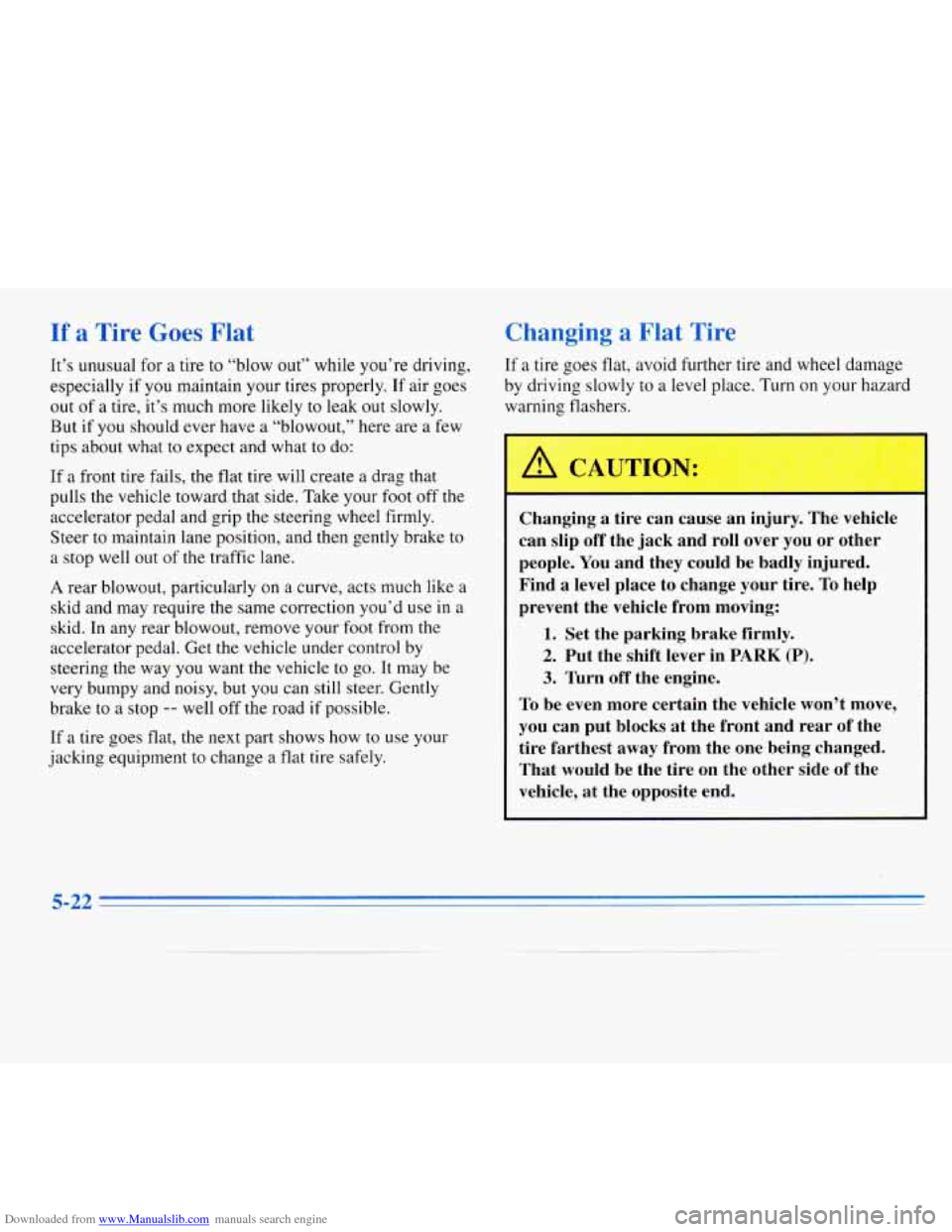
Downloaded from www.Manualslib.com manuals search engine If a Tire Goes Flat
It’s unusual for a tire to “blow out7’ while you’re driving,
especially if
you maintain your tires properly. If air goes
out of a tire, it’s much more likely
to leak out slowly.
But if you should ever have a “blowout,” here are a few
tips about what to expect and what to do:
If a front tire fails, the flat tire will create a drag that
pulls
the vehicle toward that side. Take your foot off the
accelerator pedal and grip the steering wheel firmly.
Steer
to maintain lane position, and then gently brake to
a stop well out of the traffic lane.
A rear blowout, particularly on a curve, acts much like a
skid and may require the same correction you’d use in a
skid. In any rear blowout, remove your foot from the
accelerator pedal. Get the vehicle under control by
steering the way you want the vehicle to go. It may be
very bumpy and noisy, but you can
still steer. Gently
brake to a stop
-- well off the road if possible.
If
a tire goes flat, the next part shows how to use your
jacking equipment to change a flat tire safely.
Changing a Flat Tire
If a tire goes flat, avoid further tire and wheel damage
by driving slowly to a level place. Turn
on your hazard
warning flashers.
L
Changing a tire can cause an injury. The vehicle
can slip off the jack and roll over you
or other
people. You and they could be badly injured.
Find a level place to change your tire.
To help
prevent the vehicle from moving:
1. Set the parking brake firmly.
2. Put the shift lever in PARK (P).
3. Turn off the engine.
To be even more certain the vehicle won’t move,
you can put blocks at the front and rear of the
tire farthest away from the one being changed.
That would be the tire on the other side of the
vehicle, at the opposite end.
Page 195 of 340
Downloaded from www.Manualslib.com manuals search engine The following steps will tell you how to use the jack and
change a tire. remove the
cover.
I
Turn the wing nut
counterclockwise and
remove it. Then lift
off the
spacer and remove the spare
tire. See “Compact Spare
Tire” later in
this section for
I more information about the
compact spare.
5-23
Page 196 of 340
Downloaded from www.Manualslib.com manuals search engine A
1
C
Turn the nut holding the jack and wrench counterclockwise and remove it. Then remove
the
jack and wrench. The
tools you’ll
be using include the jack (A),
socket (B) and wheel wrench (C).
Page 197 of 340
Downloaded from www.Manualslib.com manuals search engine If there is a wheel cover, loosen the nut caps with the
wheel wrench. They won’t come
off. Then, using the
flat end of the wheel wrench,
pry along the edge of the
wheel cover until it comes
off. Be careful; the edge may
be sharp.
Don’t try to remove the cover with your
bare hands. To
remove a center cap, use the wrench to pry gently at
the notch. Don’t use a tool that is narrower than the
wrench to
pry at this notch.
If your vehicle has wheel nut caps, remove them using
the wheel wrench.
5-25
Page 198 of 340
Downloaded from www.Manualslib.com manuals search engine Removing the Flat Tire and Installing the
Spare
Tire
3. Position the jack under
the vehicle and raise the
jack lift head until it fits
firmly into the notch in
the vehicle’s frame
nearest the flat tire.
1. us1118 LIK WIIC;~ wrench, loosen all the wheel nuts.
Don’t remove them yet.
2. Turn the jack handle clockwise to raise the jack lift
head a few inches.
5-26
Page 199 of 340
Downloaded from www.Manualslib.com manuals search engine Getting under a vehicle when it is jacked up is
dangerous.
If the vehicle slips off the ,jack, you
could be badly injured
or killed. Never get under
a vehicle when it is supported only by a jack.
Put the compact spare tire near you.
NOTICE:
Raising your vehicle with the jack improperly
positioned will damage the vehicle or may allow
the vehicle to fall off the jack. Be sure to fit the
jack lift head into the proper location before
raising your vehicle.
4. Raise the vehicle by turning the jack handle
clockwise. Raise the vehicle far enough off the
ground for the spare tire to
fit under the vehicle.
5. Remove all wheel nuts and take off the flat tire.
5-27
Page 200 of 340
Downloaded from www.Manualslib.com manuals search engine L
6. Remove any rust or dirt
from the wheel bolts,
mounting surfaces and
spare wheel.
Rust or dirt on the wheel, or on the parts to
which it
is fastened, can make the wheel nuts
become loose after
a time. The wheel could come
off and cause an accident. When you change
a
wheel, remove any rust or dirt from the places
where the wheel attaches to the vehicle. In an
emergency, you can use a cloth or a paper towel
to do this; but be sure to use a scraper or wire
brush later,
if you need to, to get all the rust or
dirt off.
,- , ,. ,.
Never use oil or grease on studs or nuts. If you
do, the nuts might come loose. Your wheel could
fall off, causing a serious accident.
7. Replace the wheel nuts
with the rounded end
of the nuts toward the
wheel. Tighten each
nut
by hand until the wheel
is held against the
hub.
5-28
Trending: horn, air condition, oil type, battery location, fuel filter, change key battery, air conditioning
